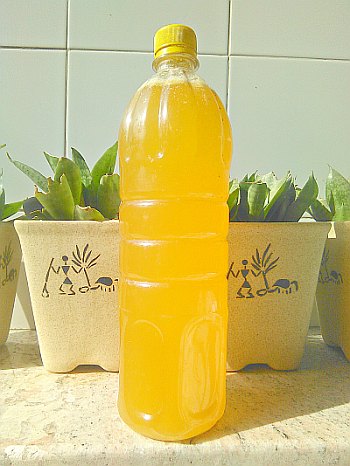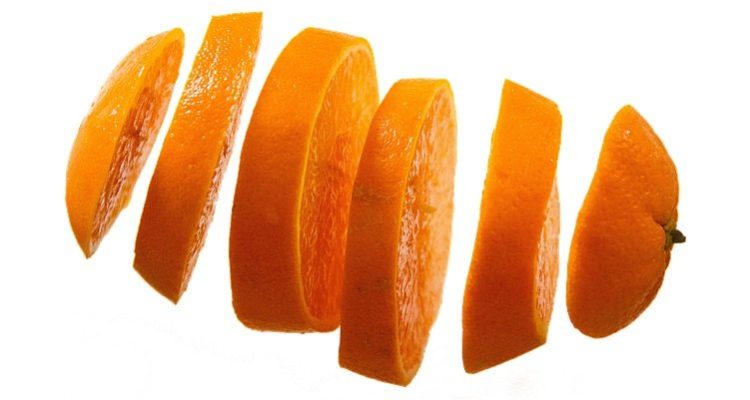It can be used instead of phenyl, Harpic, Colin, Vim Bar and what have you
◊ By Dr Supriya Mahajan Sardana, MD
About a year ago, I was acquainted with the process of making ‘Garbage Enzyme’. The name was enough to stall my interest although I had already been segregating and composting my house and kitchen waste for five years. However, I presumed it to be a cumbersome and elaborate process. How wrong I was!
 My interest in Bioenzyme was spurred again owing to a discussion led by a few bioenzyme experts and enthusiasts on a WhatsApp group. Following a very simple and short process, kilograms of rotting fruit peels, which I otherwise would have thrown into the compost pit, have metamorphosed into this sweet smelling multipurpose liquid household cleanser.
My interest in Bioenzyme was spurred again owing to a discussion led by a few bioenzyme experts and enthusiasts on a WhatsApp group. Following a very simple and short process, kilograms of rotting fruit peels, which I otherwise would have thrown into the compost pit, have metamorphosed into this sweet smelling multipurpose liquid household cleanser.
We all use cleansers and deodorisers in our homes. Then why not choose something which hurts neither us nor our environment? The numerous unnecessary chemical cleansers and add-ons we keep using mindlessly and washing down the drain into our water bodies and our soil, finally end up in our own food and on our plates.
The scientific sounding name, ‘Bioenzyme’ may lead some to think the procedure to make this cleanser is convoluted. But in reality, you only really need to dump 3 ingredients into a plastic bottle and store in a dark place for 3 months. That is literally the entire process. So bear with me.
INGREDIENTS
100 gm Jaggery/Brown Sugar
300 gm Citrus/fruit peel (orange, sweet lime, lime, lemons, pineapple, papaya, watermelon, mango, etc)
1 litre Water
The standard proportion is 1:3:10 (jaggery: fruit peel: water)
PREPARATION
Mix all three ingredients in a 2-litre PET bottle or any plastic container with a lid (the lid is a must to keep insects out).
Put a sticker on the bottle with the date on which you stock the preparation or jot it down somewhere.
Keep the bottle in a dark place for 3 months. For the first one month, open the lid or loosen the cap once a day so the gas can escape. Shake the bottle well every few days.
Over the next two months, simply leave the bottle alone and do not shake or open the lid. Once the 3-month duration is over, your concoction is ready. You will see the peels have turned into pulp.
Strain through a fine cheesecloth and store the resultant sweet/ citrusy clear liquid in an opaque or dark coloured plastic bottle or can.
TIPS
- Blend the peels in the blender or chop into small pieces if making small quantities or using containers with narrow mouths
- One could also add vegetable peels but do avoid peels of garlic, onion, potato, etc
- If you want your cleanser to smell a certain way, you can add aromatic herbs such as lemongrass, etc, to the mix
- Avoid storing the liquid in glass jars as they may crack due to gas buildup
- During the fermentation process, you may see a white hued fungal layer appear on the surface. This is a good sign and you only have to stir it back in
- Residual pulp can be composted or used as an accelerator for your next batch of peels (because you’re not going to want to buy market cleansers after trying this!)
- To expedite the process to 1 month, add a teaspoon or a few yeast tablets to the concoction. Be very regular with gas release in this case
- The ratio used for daily household cleaning is 1 part enzyme,10 parts water but for heavy duty cleaning or tougher stains, undiluted bioenzyme may be used
APPLICATIONS IN THE HOME
- Can be used to clean ceramics, steel surface grease and grime, bathrooms, chimneys, etc
- To unclog blocked drains
- As a cleaner for tiles, toilets, floors, glassware, mirrors, cars, sinks, countertops, kitchen vessels
- As pest and insect repellent (ratio 1:10)
- As plant fertiliser/foliar spray (ratio 1:20)
- Add to your washing load, along with washing powder or soap nut solution. It acts as cleaner, deodoriser and fabric softener and reduces the quantity of detergent required
- As a deodoriser for carpets and upholstery
- To clean fruits and vegetables (ratio 1:10)
- As a composting accelerator
WHY USE BIOENZYME?
- It is completely natural, non toxic, biodegradable and eco friendly and does not contain any of the harmful chemicals that industrial cleansers such as phenyl do
- Cuts down on cost considerably as you no longer need to spend on market cleansers
- It recycles your kitchen waste and reduces the carbon footprint of your household
- Easy to make
At my home, we use this magical potion for almost all of our cleaning needs and this has greatly reduced the use of expensive chemical cleansers.
The feeling of not loading the water and soil with poisons and chemical toxins, as well as, the knowledge that I’m protecting my family from harsh and unnecessary chemical based products is exhilarating and immensely satisfying. So wait! Don’t throw away those fruit peels. Make your own BIOENZYME CLEANSER TODAY!
This article was written with inputs from Sunayana Walia, Amarinder, Lalimaa, Aparna Rajagopal, Monika Khanna Gulati and Vibha.
The author is a consultant dermatologist in Delhi NCR and a proponent of natural living. She can be contacted through her website: drsupriyamahajan.in
Read the remaining two articles in the Natural Household Cleansers trilogy:




It is great blog post. I like it. Thanks for sharing these information with us.
How much with soap nut solutions for laundry
[…] Make natural household cleanser from fruit peel – this is a bioenzyme. (checked on 28 May 2018) […]